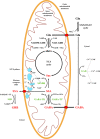Challenges and Prospects of New Plant Breeding Techniques for GABA Improvement in Crops: Tomato as an Example
- PMID: 33014001
- PMCID: PMC7500313
- DOI: 10.3389/fpls.2020.577980
Challenges and Prospects of New Plant Breeding Techniques for GABA Improvement in Crops: Tomato as an Example
Abstract
Over the last seven decades, γ-aminobutyric acid (GABA) has attracted great attention from scientists for its ubiquity in plants, animals and microorganisms and for its physiological implications as a signaling molecule involved in multiple pathways and processes. Recently, the food and pharmaceutical industries have also shown significantly increased interest in GABA, because of its great potential benefits for human health and the consumer demand for health-promoting functional compounds, resulting in the release of a plethora of GABA-enriched products. Nevertheless, many crop species accumulate appreciable GABA levels in their edible parts and could help to meet the daily recommended intake of GABA for promoting positive health effects. Therefore, plant breeders are devoting much effort into breeding elite varieties with improved GABA contents. In this regard, tomato (Solanum lycopersicum), the most produced and consumed vegetable worldwide and a fruit-bearing model crop, has received much consideration for its accumulation of remarkable GABA levels. Although many different strategies have been implemented, from classical crossbreeding to induced mutagenesis, new plant breeding techniques (NPBTs) have achieved the best GABA accumulation results in red ripe tomato fruits along with shedding light on GABA metabolism and gene functions. In this review, we summarize, analyze and compare all the studies that have substantially contributed to tomato GABA breeding with further discussion and proposals regarding the most recent NPBTs that could bring this process to the next level of precision and efficiency. This document also provides guidelines with which researchers of other crops might take advantage of the progress achieved in tomato for more efficient GABA breeding programs.
Keywords: CRISPR/Cas; GABA metabolism; breeding strategies; cis-engineering; health-promoting food; new plant breeding techniques; tomato; γ-aminobutyric acid.
Copyright © 2020 Gramazio, Takayama and Ezura.
Figures


Similar articles
-
Utilization of a Genome-Edited Tomato (Solanum lycopersicum) with High Gamma Aminobutyric Acid Content in Hybrid Breeding.J Agric Food Chem. 2018 Jan 31;66(4):963-971. doi: 10.1021/acs.jafc.7b05171. Epub 2018 Jan 19. J Agric Food Chem. 2018. PMID: 29314836
-
Efficient increase of ɣ-aminobutyric acid (GABA) content in tomato fruits by targeted mutagenesis.Sci Rep. 2017 Aug 1;7(1):7057. doi: 10.1038/s41598-017-06400-y. Sci Rep. 2017. PMID: 28765632 Free PMC article.
-
Activating glutamate decarboxylase activity by removing the autoinhibitory domain leads to hyper γ-aminobutyric acid (GABA) accumulation in tomato fruit.Plant Cell Rep. 2017 Jan;36(1):103-116. doi: 10.1007/s00299-016-2061-4. Epub 2016 Oct 4. Plant Cell Rep. 2017. PMID: 27704232
-
Inside and Beyond Color: Comparative Overview of Functional Quality of Tomato and Watermelon Fruits.Front Plant Sci. 2019 Jun 13;10:769. doi: 10.3389/fpls.2019.00769. eCollection 2019. Front Plant Sci. 2019. PMID: 31263475 Free PMC article. Review.
-
How and why does tomato accumulate a large amount of GABA in the fruit?Front Plant Sci. 2015 Aug 10;6:612. doi: 10.3389/fpls.2015.00612. eCollection 2015. Front Plant Sci. 2015. PMID: 26322056 Free PMC article. Review.
Cited by
-
Bacillus amyloliquefaciens Increases the GABA in Rice Seed for Upregulation of Type I Collagen in the Skin.Curr Microbiol. 2023 Mar 6;80(4):128. doi: 10.1007/s00284-023-03233-z. Curr Microbiol. 2023. PMID: 36877314
-
Gamma-aminobutyric acid treatment promotes resistance against Sogatella furcifera in rice.Front Plant Sci. 2024 Jul 18;15:1419999. doi: 10.3389/fpls.2024.1419999. eCollection 2024. Front Plant Sci. 2024. PMID: 39091314 Free PMC article.
-
Unveiling the secrets of abiotic stress tolerance in plants through molecular and hormonal insights.3 Biotech. 2024 Oct;14(10):252. doi: 10.1007/s13205-024-04083-7. Epub 2024 Sep 26. 3 Biotech. 2024. PMID: 39345964 Review.
-
Genome Editing for Improving Crop Nutrition.Front Genome Ed. 2022 Feb 9;4:850104. doi: 10.3389/fgeed.2022.850104. eCollection 2022. Front Genome Ed. 2022. PMID: 35224538 Free PMC article. Review.
-
Analysis of Endophytic Bacterial Communities and Investigation of Core Taxa in Apple Trees.Plant Pathol J. 2023 Aug;39(4):397-408. doi: 10.5423/PPJ.OA.05.2023.0070. Epub 2023 Aug 1. Plant Pathol J. 2023. PMID: 37550985 Free PMC article.
References
-
- Akama K., Takaiwa F. (2007). C-terminal extension of rice glutamate decarboxylase (OsGAD2) functions as an autoinhibitory domain and overexpression of a truncated mutant results in the accumulation of extremely high levels of GABA in plant cells. J. Exp. Bot. 58, 2699–2707. 10.1093/jxb/erm120 - DOI - PubMed
-
- Anan T., Ito H., Monma S. (1996). Chemical contents in fruits of transgenic tomato carrying the TMV coat protein gene, nontransgenic tomato, and other Lycopersicon species. J. Japanese Soc Hortic. Sci. 65, 635–644. 10.2503/jjshs.65.635 - DOI
Publication types
LinkOut - more resources
Full Text Sources
Research Materials

